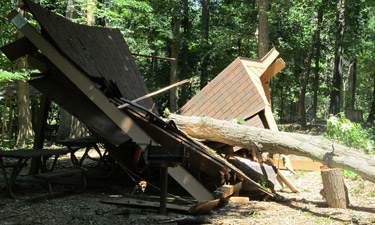 On a muggy day at the end of June 2012, heading into the July 4th holiday weekend, the offices of Montgomery Parks Silver Spring Parkside headquarters in Montgomery County, Maryland, were emptying out. Staff was gearing up for weekend getaways, picnics, and some much-needed down time. And then a derecho, a widespread, long-lived, straight-line windstorm that is associated with a fast-moving band of severe thunderstorms, rolled in.
On a muggy day at the end of June 2012, heading into the July 4th holiday weekend, the offices of Montgomery Parks Silver Spring Parkside headquarters in Montgomery County, Maryland, were emptying out. Staff was gearing up for weekend getaways, picnics, and some much-needed down time. And then a derecho, a widespread, long-lived, straight-line windstorm that is associated with a fast-moving band of severe thunderstorms, rolled in.
With warm, forceful winds gusting between 60 and 80 miles per hour, this storm—like none other the Washington, D.C., region has ever experienced—hit with a sudden wave of destruction. It knocked out power to more than one million electricity users. Five hundred of some 800 traffic signals in the county went dark. Hundreds of trees came down on power lines, cars, rooftops, and more. Damage across Montgomery Parks’ 416 parks, spanning 35,000 acres of parkland, was extensive.
Trees were strewn (more than 200 lost and many more damaged) throughout our system, one crushing the roof of an event venue reserved for a wedding that evening. Ice at our skating rinks was melted. Trails throughout our system were devastated, many inaccessible for days and even weeks. Picnic shelters were destroyed.
While we had an emergency action plan ready, we found ourselves facing a unique situation with the derecho. In addition to the extensive damage caused by the storm, the region was struck with a severe heat advisory that continued for four days after the storm moved out. Temperatures soared above 100 degrees. Power crews were not prepared for the extent of the circumstances. It took 10 days before all residents in the county had electricity restored.
The storm is now a little more than three months behind us, and while clean-ups are still underway and may continue through the end of the year at some locations, much of the severe damage and destruction has been taken care of thanks to the unparalleled dedication of our staff, who have put in more than 10,000 work hours (to date) to address more than 1,100 work orders.
This crisis, similar to others we have encountered in the not-too-distant past (Snowmageddon 2010 and a leak at Lake Needwood Dam), has afforded us with new experiences and valuable lessons learned which we can draw from for future situations.
“It Takes a Village”
While we knew we’d need all hands on deck for this crisis, what we realized rather quickly was that we needed to designate damage assessment leaders and to create a set of criteria for the assessments (physical damage, power issues, safety issues, etc.). It was also important to determine who would receive and process this information, and how we would prioritize restoration and clean-up efforts.
Create a Command Center
Establishing an emergency operations center (whether this is a virtual center, a physical location, or some combination of the two) provides a central hub where work orders can be submitted, prioritized, and assigned.
Highlight the Positive
Crisis situations drain energy and morale. Team leaders need to regularly praise frontline responders to let them know their time and the hard work that is being done in difficult circumstances is of the utmost importance and much appreciated.
Be Flexible
Extenuating circumstances often require rules be broken and guidelines bent. Purchasing procedures may need to be relaxed so that necessary resources can be accessed. Staff may need to be reassigned to address areas of urgent need.
Keep Communication Lines Open and Updated
Determine your communication methodology (web, conference calls, land lines, cellular lines, work order systems) and clearly define who will handle updating these different channels. Frequent updates should be provided to staff, the public, and elected and appointed officials so that everyone affected is informed.
Mike Riley is Deputy Director of Montgomery Parks, which is part of the Maryland-National Capital Park and Planning Commission. Riley is a registered professional engineer with 27 years of experience in park management.
Five Lessons Learned from the Derecho
October 1, 2012, Department, by Mike Riley

